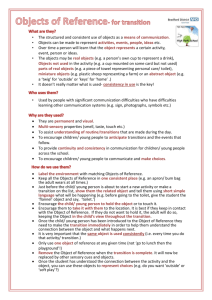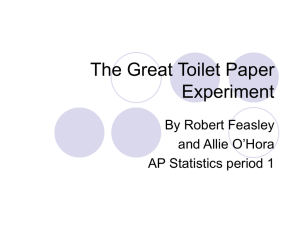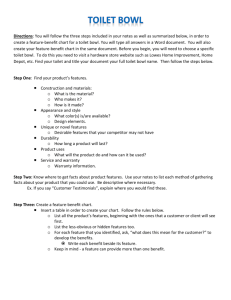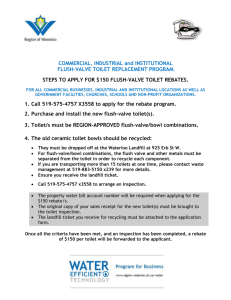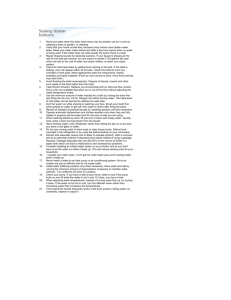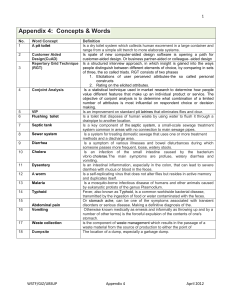The Tricky Business of Rolling Out a New Toilet Paper, 1
advertisement
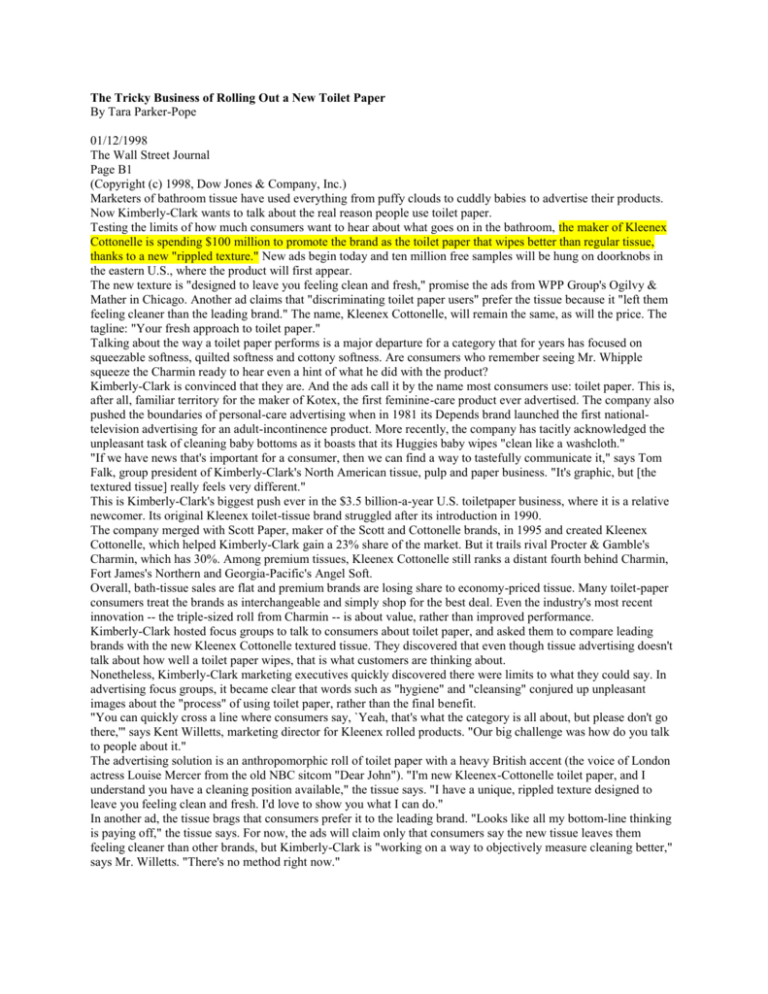
The Tricky Business of Rolling Out a New Toilet Paper By Tara Parker-Pope 01/12/1998 The Wall Street Journal Page B1 (Copyright (c) 1998, Dow Jones & Company, Inc.) Marketers of bathroom tissue have used everything from puffy clouds to cuddly babies to advertise their products. Now Kimberly-Clark wants to talk about the real reason people use toilet paper. Testing the limits of how much consumers want to hear about what goes on in the bathroom, the maker of Kleenex Cottonelle is spending $100 million to promote the brand as the toilet paper that wipes better than regular tissue, thanks to a new "rippled texture." New ads begin today and ten million free samples will be hung on doorknobs in the eastern U.S., where the product will first appear. The new texture is "designed to leave you feeling clean and fresh," promise the ads from WPP Group's Ogilvy & Mather in Chicago. Another ad claims that "discriminating toilet paper users" prefer the tissue because it "left them feeling cleaner than the leading brand." The name, Kleenex Cottonelle, will remain the same, as will the price. The tagline: "Your fresh approach to toilet paper." Talking about the way a toilet paper performs is a major departure for a category that for years has focused on squeezable softness, quilted softness and cottony softness. Are consumers who remember seeing Mr. Whipple squeeze the Charmin ready to hear even a hint of what he did with the product? Kimberly-Clark is convinced that they are. And the ads call it by the name most consumers use: toilet paper. This is, after all, familiar territory for the maker of Kotex, the first feminine-care product ever advertised. The company also pushed the boundaries of personal-care advertising when in 1981 its Depends brand launched the first nationaltelevision advertising for an adult-incontinence product. More recently, the company has tacitly acknowledged the unpleasant task of cleaning baby bottoms as it boasts that its Huggies baby wipes "clean like a washcloth." "If we have news that's important for a consumer, then we can find a way to tastefully communicate it," says Tom Falk, group president of Kimberly-Clark's North American tissue, pulp and paper business. "It's graphic, but [the textured tissue] really feels very different." This is Kimberly-Clark's biggest push ever in the $3.5 billion-a-year U.S. toiletpaper business, where it is a relative newcomer. Its original Kleenex toilet-tissue brand struggled after its introduction in 1990. The company merged with Scott Paper, maker of the Scott and Cottonelle brands, in 1995 and created Kleenex Cottonelle, which helped Kimberly-Clark gain a 23% share of the market. But it trails rival Procter & Gamble's Charmin, which has 30%. Among premium tissues, Kleenex Cottonelle still ranks a distant fourth behind Charmin, Fort James's Northern and Georgia-Pacific's Angel Soft. Overall, bath-tissue sales are flat and premium brands are losing share to economy-priced tissue. Many toilet-paper consumers treat the brands as interchangeable and simply shop for the best deal. Even the industry's most recent innovation -- the triple-sized roll from Charmin -- is about value, rather than improved performance. Kimberly-Clark hosted focus groups to talk to consumers about toilet paper, and asked them to compare leading brands with the new Kleenex Cottonelle textured tissue. They discovered that even though tissue advertising doesn't talk about how well a toilet paper wipes, that is what customers are thinking about. Nonetheless, Kimberly-Clark marketing executives quickly discovered there were limits to what they could say. In advertising focus groups, it became clear that words such as "hygiene" and "cleansing" conjured up unpleasant images about the "process" of using toilet paper, rather than the final benefit. "You can quickly cross a line where consumers say, `Yeah, that's what the category is all about, but please don't go there,'" says Kent Willetts, marketing director for Kleenex rolled products. "Our big challenge was how do you talk to people about it." The advertising solution is an anthropomorphic roll of toilet paper with a heavy British accent (the voice of London actress Louise Mercer from the old NBC sitcom "Dear John"). "I'm new Kleenex-Cottonelle toilet paper, and I understand you have a cleaning position available," the tissue says. "I have a unique, rippled texture designed to leave you feeling clean and fresh. I'd love to show you what I can do." In another ad, the tissue brags that consumers prefer it to the leading brand. "Looks like all my bottom-line thinking is paying off," the tissue says. For now, the ads will claim only that consumers say the new tissue leaves them feeling cleaner than other brands, but Kimberly-Clark is "working on a way to objectively measure cleaning better," says Mr. Willetts. "There's no method right now." The rippled texture is the result of a patented technology that dries the tissue during manufacturing without crushing it flat and later embossing it, the older approach. This method also allows the tissue to hold its rippled shape when wet, allowing it to clean better, the company says. Thanks to a $170 million investment in a Beach Island, S.C., manufacturing site, the process uses less fiber while improving the bulk and strength of the tissue. As a result, the company's manufacturing costs per roll are 20% less than those for other premium tissues. With the price to consumers remaining the same, the extra margin will help Kleenex Cottonelle better withstand the price wars plaguing the tissue category and let the company spend more on marketing and advertising to grab market share. "It's a very delicate thing, but it has the potential, if it's done right, of taking a major share of the toilet paper market," says George Rosenbaum, chief executive of Chicago market researcher Leo J. Shapiro & Associates. "When you revisit cleaning, you're opening up a number of issues that years of product promotion have been silent about." The $100 million launch budget is more than double what Kimberly-Clark spent on the brand last year. About $20 million to $30 million will go toward national television advertising, including 18 weeks of prime-time TV. In addition to the door-to-door sampling, another million single rolls will be available in stores for 50 cents each in the Eastern U.S. As is typical in the paper-products industry, it probably will be at least 18 months before the product is available elsewhere, because Kimberly-Clark will have to build a new tissue-making plant to supply the remaining two-thirds of the country. In the meantime, the company will launch a new, softer version of Kleenex Cottonelle in the rest of the U.S. Those more-traditional ads show a bubble drifting onto folds of toilet tissue. But the product package includes the "clean, fresh feeling" promise, in an effort to prime consumers for the eventual appearance of the textured tissue nationwide. --Bathroom Brawl Kimberly-Clark hopes a new rippled texture will boost its Kleenex Cottonelle brand. Here are sales of toilet-tissue industry leaders, in billions of dollars for 52 weeks ending Nov. 23. Company Total Sales Charmin $1.052 Northern 0.481 Scott 0.434 Private Label 0.387 Angel Soft 0.373 Kleenex Cottonelle 0.360 Total category 3.487 Change From 1996 - 2.4% + 0.6 - 2.6 + 4.2 + 8.6 (n/a)-a + 0.3 a-New brand following merger of Kimberly-Clark and Scott Paper Source: Information Resources Inc. --Ad Notes. . . . CHANGE IN DUTIES: Ammirati Puris Lintas said Duncan Pollack has given up his duties as chairman and chief executive officer of its New York ad agency, in response to significant growth of its North American operations. Mr. Pollack, 54 years old, remains president of Ammirati's North American operations. The agency said Martin Puris, Ammirati's world-wide chairman and CEO, will have oversight for the New York office until a successor can be named. The agency expects to hire someone from the outside. Mr. Pollack said Ammirati's New York office has picked up about $400 million in new billings this year, from clients including General Motors and Ameritech. Ammirati is part of Interpublic Group. AD EXECUTIVE: Wells BDDP, the New York ad agency whose biggest client is Procter & Gamble, is losing another top ad executive. Douglas Atkin, an executive vice president and director of account planning, has joined Omnicom's Merkley Newman Harty as a partner and head of strategic planning. The exit of Mr. Atkin, 41, marks the third executive departure from the New York ad agency in the past six months. Wells is part of the BDDP Group, which is owned by London's GGT. CORPORATE CAMPAIGN: Kaiser Permanente, Oakland, Calif., said it handed its estimated $25 million corporate advertising campaign to Grey Advertising. DIRECT MARKETING: Lowe & Partners/SMS said it named Neil Fox chairman and chief executive officer of its newly expanded direct-marketing operations, Lowe Fox Pavlika. Mr. Fox, 57, was previously chairman, CEO and president of Fox Pavlika & Partners, which Lowe has acquired and merged into its own directmarketing division. Terms weren't disclosed. Lowe, whose big clients include Mercedes-Benz and Sun Microsystems, is part of Interpublic Group. MANAGING DIRECTOR: J. Walter Thompson named Debra Brown managing director of the New York office of its direct-marketing company, JWT Direct. Ms. Brown, 45, was previously an executive vice president at Young & Rubicam, and also worked at Y&R's big Wunderman Cato Johnson direct-marketing company. Thompson is part of WPP Group.
